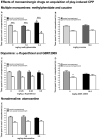The neurobiology of social play and its rewarding value in rats
- PMID: 27587003
- PMCID: PMC5074863
- DOI: 10.1016/j.neubiorev.2016.07.025
The neurobiology of social play and its rewarding value in rats
Abstract
In the young of many mammalian species, including humans, a vigorous and highly rewarding social activity is abundantly expressed, known as social play behaviour. Social play is thought to be important for the development of social, cognitive and emotional processes and their neural underpinnings, and it is disrupted in pediatric psychiatric disorders. Here, we summarize recent progress in our understanding of the brain mechanisms of social play behaviour, with a focus on its rewarding properties. Opioid, endocannabinoid, dopamine and noradrenaline systems play a prominent role in the modulation of social play. Of these, dopamine is particularly important for the motivational properties of social play. The nucleus accumbens has been identified as a key site for opioid and dopamine modulation of social play. Endocannabinoid influences on social play rely on the basolateral amygdala, whereas noradrenaline modulates social play through the basolateral amygdala, habenula and prefrontal cortex. In sum, social play behaviour is the result of coordinated activity in a network of corticolimbic structures, and its monoamine, opioid and endocannabinoid innervation.
Keywords: Amygdala; Dopamine; Endocannabinoids; Noradrenaline; Nucleus accumbens; Operant conditioning; Opioids; Place conditioning; Prefrontal cortex; Reward; Social play behaviour.
Copyright © 2016 Elsevier Ltd. All rights reserved.
Figures


Similar articles
-
Dopaminergic Neurotransmission in the Nucleus Accumbens Modulates Social Play Behavior in Rats.Neuropsychopharmacology. 2016 Aug;41(9):2215-23. doi: 10.1038/npp.2016.22. Epub 2016 Feb 10. Neuropsychopharmacology. 2016. PMID: 26860202 Free PMC article.
-
On the central noradrenergic mechanism underlying the social play-suppressant effect of methylphenidate in rats.Behav Brain Res. 2018 Jul 16;347:158-166. doi: 10.1016/j.bbr.2018.03.004. Epub 2018 Mar 8. Behav Brain Res. 2018. PMID: 29526788
-
Dissociating the role of endocannabinoids in the pleasurable and motivational properties of social play behaviour in rats.Pharmacol Res. 2016 Aug;110:151-158. doi: 10.1016/j.phrs.2016.04.031. Epub 2016 May 3. Pharmacol Res. 2016. PMID: 27154553 Free PMC article.
-
The endocannabinoid system and nondrug rewarding behaviours.Exp Neurol. 2010 Jul;224(1):23-36. doi: 10.1016/j.expneurol.2010.03.020. Epub 2010 Mar 29. Exp Neurol. 2010. PMID: 20353776 Review.
-
Effort-related functions of nucleus accumbens dopamine and associated forebrain circuits.Psychopharmacology (Berl). 2007 Apr;191(3):461-82. doi: 10.1007/s00213-006-0668-9. Epub 2007 Jan 16. Psychopharmacology (Berl). 2007. PMID: 17225164 Review.
Cited by
-
The effects of social deprivation on adolescent development and mental health.Lancet Child Adolesc Health. 2020 Aug;4(8):634-640. doi: 10.1016/S2352-4642(20)30186-3. Epub 2020 Jun 12. Lancet Child Adolesc Health. 2020. PMID: 32540024 Free PMC article. Review.
-
Play partner preferences among groups of unfamiliar juvenile male rats.Sci Rep. 2024 Jul 11;14(1):16056. doi: 10.1038/s41598-024-66988-w. Sci Rep. 2024. PMID: 38992171 Free PMC article.
-
Maternal allergic inflammation in rats impacts the offspring perinatal neuroimmune milieu and the development of social play, locomotor behavior, and cognitive flexibility.Brain Behav Immun. 2021 Jul;95:269-286. doi: 10.1016/j.bbi.2021.03.025. Epub 2021 Mar 30. Brain Behav Immun. 2021. PMID: 33798637 Free PMC article.
-
Sex and age differences in social and cognitive function in offspring exposed to late gestational hypoxia.Biol Sex Differ. 2023 Nov 11;14(1):81. doi: 10.1186/s13293-023-00557-0. Biol Sex Differ. 2023. PMID: 37951901 Free PMC article.
-
The role of social isolation in opioid addiction.Soc Cogn Affect Neurosci. 2021 Jul 6;16(7):645-656. doi: 10.1093/scan/nsab029. Soc Cogn Affect Neurosci. 2021. PMID: 33681992 Free PMC article.
References
Publication types
MeSH terms
Substances
Grants and funding
LinkOut - more resources
Full Text Sources
Other Literature Sources

